WOMEN IN AVIATION
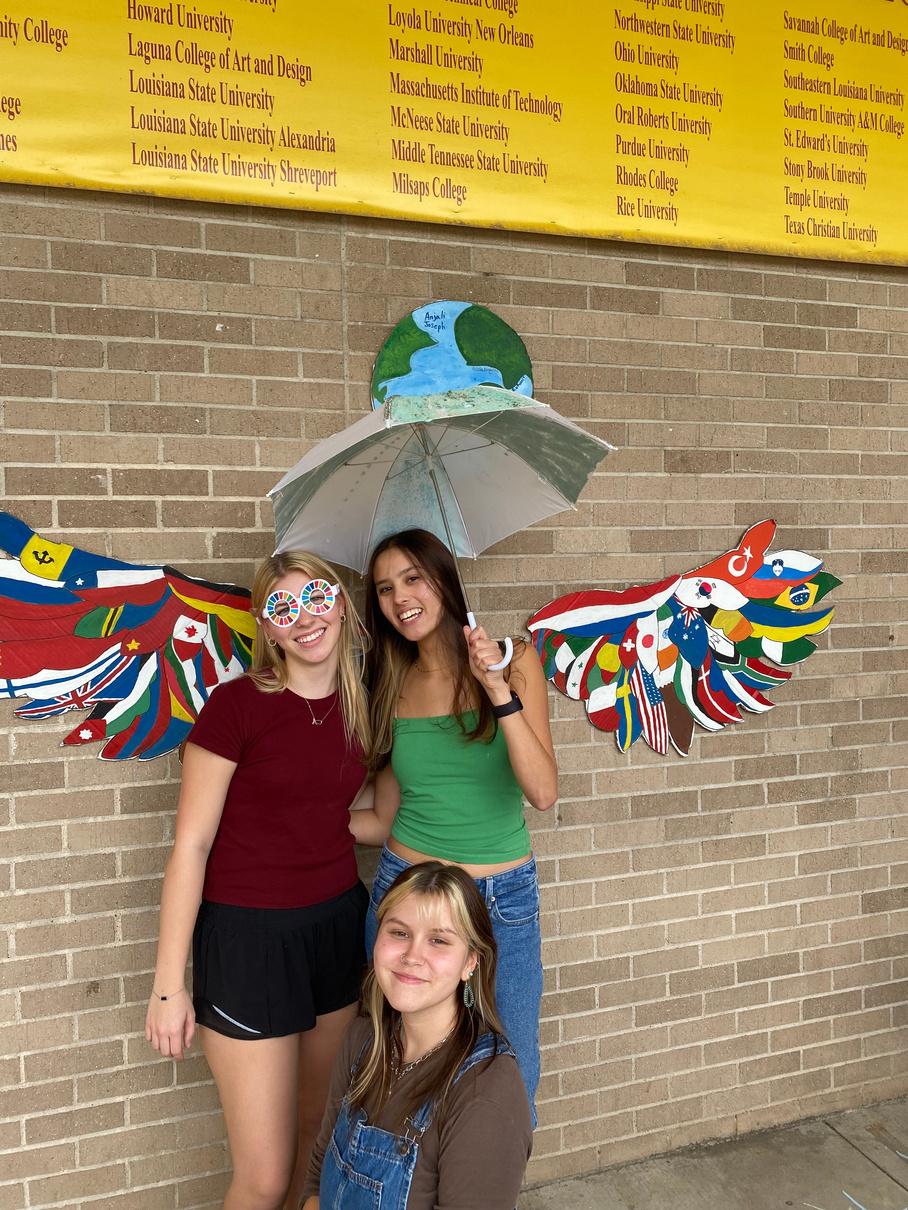

THE BECHDEL TEST
LITERARY BARRIERS



DARIA KASATKINA
OUR NEW CO-SPONSOR
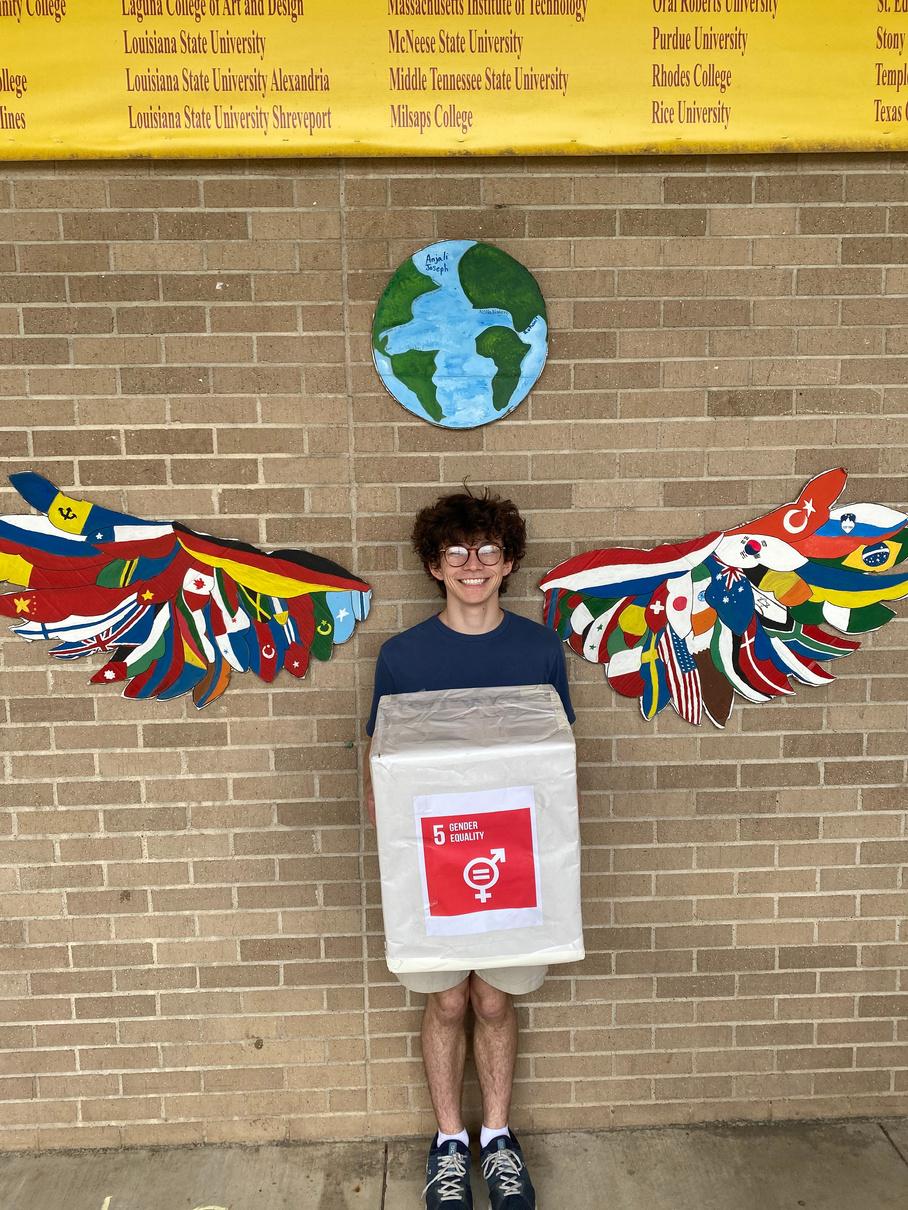
Brought to you by

CMHS GIRL UP
Executive Editors:
Ruby Knoebel and Anjali Veerareddy
Dear Readers,
We are so excited to be presenting the first Ms. Magnet issue of the 2023-2024 school year! This magazine provides a unique opportunity for Magnet students to present their work and passion for gender equality. Thank you to everyone who contributed to this magazine; we appreciate all of the support from club members and teachers who made this possible.
The inspiration for Ms. Magnet, Ms. magazine, drew attention to global women ’ s issues, and we hope that Ms. Magnet can do the same on our campus. With articles about a female tennis player, the history of female environmentalists, and an interview of a female pilot, this magazine attests to the curiosity and passion of our Magnet community. We hope you enjoy this issue!
Sincerely,
Anjali and Ruby
EEditors’ ditors’ NNote ote

ELEANOR

WOMEN
Kaylie Nahn
LITERARY BARRIERS
Parker Alleman
METAMORPHOSES
Renaye Harris

Why Ms. Magnet...
By Rishi SultanaMs. Magnet was the brainchild of our previous presidents, Ananya and Natalie. But for the newcomer... where does that name come from?
Truly, it’s unsurprising that the iconic feminist magazine Ms. became the inspiration for founding Ms. Magnet. It was a highly controversial magazine for its time, a “brazen act of independence” for women in the 1970s, founded in part by feminist journalist Gloria Steinem. However, it ended up being America’s first national magazine to make feminist voices audible, bringing forth issues that no reporter of the time could bear to address for fear of retribution—from sexual harassment to the impact of advertising on women’s beauty standards. Ms. existed as a safe space for women’s issues; a home for change as the female empowerment movement continued to grow through the 70s and beyond.

I clearly remember the meeting in my freshman year where Ananya and Natalie asked for publication title suggestions: the Menstruation Publication, Girlboss Mag... but the name Ms. Magnet always lingered. There was something so catchy about it— something that made it uniquely Magnet, other than just the fact that our name was a part of it. Looking back, it means that now, in every issue of Ms. Magnet we publish, we aren’t just honoring the present of feminism but also its history.
Much like Ms. was a place for women to tell their stories, preach their issues, and fight for what they believed in, Ms. Magnet now serves as a safe space for the works of our students— regardless of if you’re male, female, or anyone outside of that spectrum. It is not just a place for you to showcase your feminist works but also to tell your own stories. Whether that lies in an interview with your mother or a close family friend, a poem, an artwork, or elsewhere, don’t be afraid to submit anything you make!
Ms. Sweeten
OUR NEW CO-SPONSOR!
interview by Sadie Sledge
WHO IS YOUR BIGGEST ROLE MODEL?
My grandmother. She basically raised me as I was growing up. She taught me how to read and other necessary skills.
HOW HAVE THE WOMEN IN YOUR LIFE INFLUENCED YOU?
Again, my grandmothers have influenced me significantly throughout my life. They sacrificed everything to raise me and I would be where I am today without them.
WHAT MADE YOU WANT TO COME TO MAGNET?
Who wouldn’t want to? To teachers at other schools, Magnet is pretty much the dream school to be at.
WHY DID YOU BECOME A TEACHER?
DO YOU EXPERIENCE CHALLENGES AS A WOMEN IN THE WORKPLACE?
I think quite often women are expected to do everything. The double standard reigns strong which is the main issue in the workplace. Another thing--maternity leave is a complete joke. It’s almost impossible to raise a child and work at the same time with the amount of time given, 6-8 weeks.
I had some terrible experiences when I was at school and I really wanted to prevent that from happening to other students now.
ANY FINAL THOUGHTS ON GIRL UP?
I am so impressed with the foundation and students leading Girl Up. As we go into the year, I am so excited to see what we accomplish.

Female Environmentalists
by Arjun Desai
While we are all extremely aware of groundbreaking work of famous environmentalists like Henry David Thoreau, Charles Darwin, and John Muir, many people do not even know about some of their female counterparts that have made just as, if not more, significant contributions to the struggle for environmental justice and saving our beloved mother Earth. We as a society must heed the warning of one of the earliest American activists Abigail Adams and “remember the ladies.” Below are some of the most prolific natural advocates that have furthered the fight and strived to improve quality of life through environmental work.
One of the most influential environmentalists was Rachel Carson (1907-1964). Carson was a biologist that is best known for her work on pollution and the sea. Herwritings on the hazardous use of pesticides in the ‘60s and ‘70s received incredible backlash. She was told that she was a communist, too emotional, a gross exaggerator, among a multitude of other insults. Despite this, she persevered and her books are now lauded as the “most influential
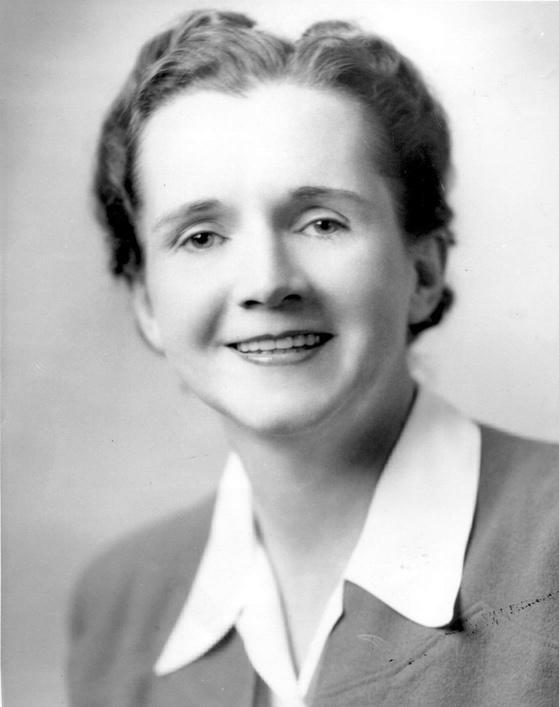
environmental writing ever published.”
Another environmental activist that is more well known is Greta Thunberg (2003-present). The Swedish environmentalist is often referred to as the youngest advocate ever. Starting her work at only fourteen years old, she is most concerned with climate change and the carbon footprint of people around the world. She has spoken out against the overuse of fossil fuels, refuses to take planes because of their large negative impact, is a vegan because of the gases emitted from livestock, and has even taken on Andrew Tate.

Finally, Wangari Maathai (19402011) stepped out of her gender role in her home country of Kenya. Maathai, activist and politician, became the first African woman to win a Nobel Prize. She founded one of the most famous grassroots organizations striving to empower women through tree planting called the Green Belt Movement. Throughout her life she tackled issues surrounding deforestation, as well as AIDS and natural resource depletion.
 Rachel Carson, Greta Thunberg, and Wangari Maathai (left to right)
Rachel Carson, Greta Thunberg, and Wangari Maathai (left to right)
Eleanor Roosevelt’s Role in Feminism
By Eleanor LokitzEleanor Roosevelt, a former First Lady of the United States, stated that she must become a suffragist because her husband had declared himself one. Despite this surprisingly domestic start, Ms. Roosevelt became a prominent figure in several social movements benefiting the poor and working class women of America. She believed that because of the distinct differences between men and women, women have an obligation to participate in America’s political society. Her argument denounced the idea of a separate women’s party in the government, explaining that female leaders backed by the unified force of women would create change. In 1920, she joined the New York State League of Women’s Voters and directed the Women Voters’ national-legislation committee which worked to increase voting participation in women. She fully believed that women needed to insert themselves into the political atmosphere and become leaders. Similarly, Eleanor Roosevelt joined the Women’s Trade Union League, a league dedicated to organizing and protecting the rights of working women in America. The WTUL unified women from all social classes working towards better, more equal
working conditions.
While Eleanor Roosevelt’s roles in these leagues were significant, her arguably most influential role was as First Lady of the United States. She held notable power over her husband’s decisions, lobbying for him to appoint more women into political office. For example, Eleanor Roosevelt's influence led to the first female head of the Department of Labor, Frances Perkins. She also fought to include women in the New Deal. In 1933, she sponsored a White House Conference on the Emergency Needs of Women, where she gathered influential figures from several organizations such as the Women’s Trade Union League and League of Women’s Voters. Through this, they worked to provide employment for women during the depression.
Eleanor Roosevelt was known as the most active and influential First Lady of the United States. Her political and social contributions for women are still seen today. Despite her reluctant beginning in the suffrage movement, Eleanor Roosevelt became a powerful feminist and changed the role of the First Lady.
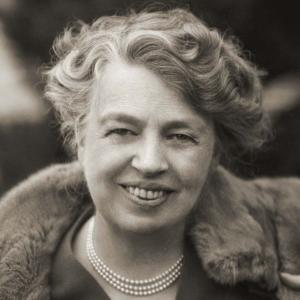
Women In Aviation: Spotlight On Morgan Carney
By Kaylie NhanShort Bio:
My name is Morgan Carney! I am from Scranton, Pennsylvania, and currently live on the island of Oahu in Hawaii. I am a First Officer for Hawaiian Airlines and fly the Boeing 717 around the Hawaiian Islands. I am hoping to upgrade to Captain soon!

How did you get into aviation? Did you know you always wanted to be a pilot?
I was introduced to aviation early on because my dad is an airline pilot. However, growing up I did not want to be a pilot and actually wanted to be a doctor up until my sophomore year in high school. During that year, I went on an introductory flight in a Cessna 172 at a small airport in Pennsylvania. After that flight, I realized I wanted to pursue aviation in college. During college and flight training, I realized I made the right career choice because I really clicked with my classmates and truly enjoyed going to the airport everyday for lessons.
Did you ever receive any doubt (whether from yourself or from others) during the education/training process? If so, how did you overcome it? Yes! I think having doubts or concerns in yourself is normal for anyone and it shows you care. Anytime I became stressed during training, I recognized it as myself just caring a lot. In order to ease that feeling I would prepare immensely for each session as well do self-care. The feeling of success after achieving something you were initially worried about is amazing. You can do anything you put your mind to.
Do you ever feel a lot of pressure from flying in the cockpit? How do you calm your nerves?
When I go to work I feel little to no pressure because of a combination of the training and experience I have. The most stressful “flying” for me is in the simulator. We get put through extensive training exercises at all times of the day for long periods of time where we have to perform difficult maneuvers with little room for failure. Errors in the sim can remove someone from the flight line and potentially lead to termination. However, because of the “pressure” in the simulator, I feel more confident in the real life cockpit. I calm my nerves before a simulator session by spending a lot of time preparing as well as by doing self care. I will run, eat a great meal, and make sure I sleep enough the night before.
According to the Air Line Pilots Association (ALPA), only 6% of airline pilots are women. What barriers or challenges have you faced in the workforce as a woman?
In the airline training environment, it is common to be the only person of your gender in the room for six plus weeks. One of my least favorites is when people say we can get hired anywhere BECAUSE we are female. Not true. We get hired because we meet the qualifications and put ourselves through the hiring process. For example, some pilots have said “it used to be hard to get hired here” to me when we both went through the same hiring process and met the same requirements. Others will repeat basic pilot knowledge or clearances in an attempt to “teach” me meanwhile it is information that I wouldn’t be sitting in an airline seat without knowing. Lastly, being confused for a flight attendant is a common occurrence. For example, a couple of months ago, I arrived at the gate to go down the jet bridge to the plane (in uniform) and the gate agent wouldn’t let me on ‘until the pilots got there’! I said “I am the pilot.” This is a screenshot of an email exchange between myself and my last airline boss. The “yes, sir” made me laugh.

Do you feel you’re held to a double standard compared to male pilots?
Absolutely. It is more apparent to me as I prepare to upgrade and become a captain. For example, if a woman in the Captain position’s demeanor is too direct, abrasive, or aggressive she can be called bossy and other derogatory terms. On the other hand, when people of the opposite gender display leadership traits that could be called cooperative, accommodating, flexible, agreeable, and friendly, they are considered overly feminine – intended as an insult – and weak, incompetent, untrustworthy, and unworthy of respect. Sometimes it is unfortunately like having to walk a tightrope. Another real way the double-standard manifests is how a woman learning to fly can be viewed as “adorable,” with people falling all over themselves to tutor and mentor them, but when the same person dares progress to become a professional pilot or upgrade from First Officer to captain, suddenly the attitude shifts to "who do you think you are?" and “you’re too big for your britches” and “you don’t know your place,” which can lead to behavior intended to "put you in your place.”
Imposter syndrome—the feeling of self doubt and not belonging—is very prevalent among women in the workforce. Have you ever felt it?
I have not personally experienced this; however, I’ve had conversations with close friends in the industry about their experience with this. I understand this feeling almost acts as an “ambition penalty.” For example, one of my friends started out as a flight attendant and then decided to go learn how to fly. She worked her way up and is now at a major airline as a First Officer. She expresses that she feels this way sometimes.
Who are some women that are an inspiration or role models for you?
Honestly the plethora of females I have met who have paved the way for the next generations are always inspiring, whether it’s the female pilot networking groups, the female entrepreneurs, or even Girl Up paving the path forward for all of us!
Currently, women make up the majority of flight attendants, while men make up the majority of pilots. Do you think this trend will change in the future?
Yes! I see it slowly becoming more equal at my current job! I’ve worked with more female captains and male flight attendants than I did in prior years at my other airline.

What advice would you give to girls wanting to go into male-dominated fields/careers?
I highly highly recommend putting yourself in a field or career that will give you freedom. I recommend aviation because the freedom that comes with the career will help you achieve whatever life you want as well as never have to rely on anyone. Seriously! If you want to travel the world and be gone for days on end, you can; if you want to be home every night, you can; if you want to not work and still get paid, you can! You have the ability to live anywhere in the world. Aviation and more specifically becoming an airline pilot is a career track I will ALWAYS recommend to young women despite it being male dominated.
Some other quick tips:
Show up and be early.
Believe in Yourself: Have confidence in your abilities and know that your gender doesn't define your potential in any field.
Find Role Models and Mentors: Look for women who have succeeded in your chosen field as inspiration and guidance. (Something absolutely incredible about the aviation community is that 99.9% of everyone wants to help build each other up.)

Pursue Education and Training: Focus on acquiring the necessary knowledge and skills to excel in your chosen field. The cost of this is going to be scary at first but I promise if you can not think about the money during this process, it will help you. AND the money will come.
Network and Connect: Build a professional network to access opportunities and advice from others in your field.
Build Up Other Women Around You: Do not partake in gossip or negative talking of colleagues. In small fields, people get reputations fast! If you hear negative talk about a fellow coworker, shut it down.
Be Persistent: Success often requires perseverance, so don't give up easily on your goals.
Last question: What’s your favorite part about
flying?
I love almost everything about flying; however, my favorite aspect is the take off. All the preparation and moving parts come together and it’s utter complete focus as the crew prepares for a rejected takeoff, an engine failure, or a normal takeoff. The feeling you get is addicting. Nothing else matters in that moment and all my little worries from the day stay on the ground.
1. 2. 3. 4. 5. 6. 7.Shattering Literary Barriers Shattering Literary Barriers
By Parker Alleman By Parker AllemanIn the hallowed halls of classic literature, names like George Eliot, Currer Belle, A.M. Barnard, George Sand, and Vernon Lee resonate through high school English classrooms and beyond. Yet, beneath these pseudonyms lies a shared secret: none of them are real.
George Eliot, in truth, is Mary Ann Evans; Currer Belle is Charlotte Brontë; A.M. Barnard is none other than Louisa May Alcott, and the list goes on.
Why, one might wonder, did these esteemed authors choose to hide behind pen names? Charlotte Brontë once confided that she “had a vague impression that authoresses are liable to be looked on with prejudice.” In essence, she feared that, solely by virtue of being a woman, her work would be met with diminished acclaim and sales. At that time, a mere 10% of books bore the names of women as their authors. Although this figure slowly climbed, a seismic shift occurred in 1970.
In the present day, not only do women dominate the literary landscape, but books written by female authors boast higher average sales than those penned by men. This distinction places literature in a league of its own, standing as the sole creative domain where women lead the way. For context, in 2022, less than 20% of the top 250 films were directed by women, and only 10% of cinematographers were female. In the same year, 30% of the artists on the Billboard Hot 100 were women. Among commercially successful humanities, Literature remains an outlier.
To explain this triumph, a constellation of credible hypotheses emerges:
1. Publishing Empires Steered by Women: The helm of many publishing houses is occupied by women.

2. A Haven for Caregivers: Given the disproportionate caregiving role shouldered by women, careers affording flexibility and work-from-home opportunities are favored. Being an author checks both boxes.
3. Influential Media Anchored by Women: Platforms like Oprah's Book Club, Reese Whitherspoon’s recommendations,and BookTok drive book visibility and demand, and are predominantly operated by women.
majority of readers are women.
5. Economics at Play: Writing often yields modest financial returns. Under the constraints of patriarchy, men are steered toward more lucrative pursuits, potentially dissuading them from writing.
Regrettably, while literature is better off than its related fields, sexism still casts a long shadow over literature. An analysis of nearly 200 popular fiction books unveiled that those with male protagonists outsold their female-led counterparts by an average of 10 million copies. Furthermore, female-authored books are priced 45% lower than their male-authored counterparts. Furthermore, men are not engaging with books penned by women at a comparable rate. A study conducted by Queen Mary University revealed that roughly four out of five men reported reading a book written by a man as their last literary endeavor, while women exhibited near equal likelihood of reading books by either gender. This amalgamation of disparities contributes to a disheartening fact: despite the majority of creative writing master's degrees being held by women…less than 50% of the bestselling novels are written by women.

So, what avenues are open to address this imbalance? The issue of unequal compensation for women's books can be confronted within publishing houses, or authors can opt for independent publishing. While a price gap persists in indie publishing, it diminishes to a mere 7%. Although this figure is still far from ideal, it marks a significant improvement. As for the challenge of male readers avoiding women's books, a substantial part of this may stem from the fact that the lion's share of books reviewed in literary magazines are penned by men. A Vida study discovered that only “20% of books reviewed in the New York Review of Books, 30% in Harper's, 29% in the Atlantic, and 22% in the London Review of Books… ” were authored by women. Given the crucial role of literary magazine reviews for authors lacking robust brand recognition, rectifying this
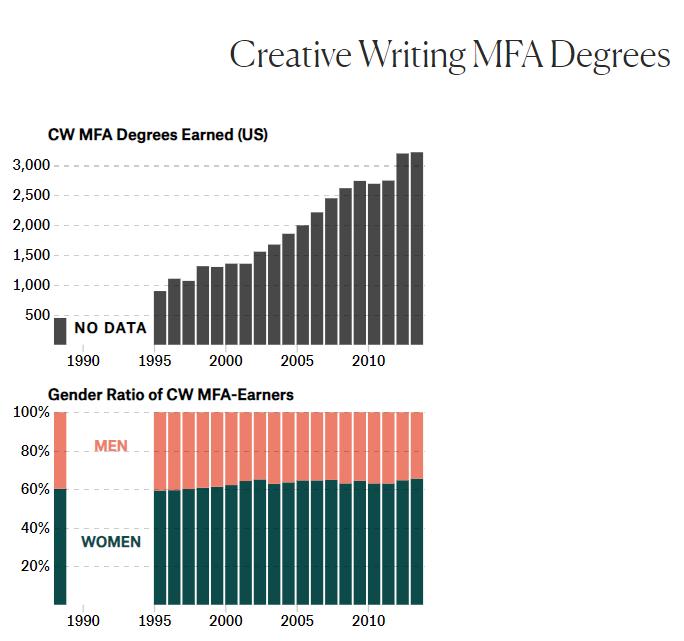
imbalance could reshape how men perceive women's literature, potentially leading to increased readership. While none of these solutions will singlehandedly bring about gender parity in literature, they represent significant strides toward that goal.
Before I conclude, you may wonder why this issue merits your attention. Aside from the fact that injustice is inherently wrong and should be rectified at every turn, there exists a practical reason why feminists should be particularly invested in the cause of authoresses. Historically, each wave of feminism has been catalyzed by the written word. The first wave's Seneca Falls Declaration facilitated the widespread dissemination of the movement's ideals. The second wave was ignited by Betty Friedan's Feminine Mystique. The third wave was christened by writer Rebecca Walker, herself the daughter of the illustrious author Alice Walker. While it may be too early to pinpoint the exact genesis of the fourth wave, many attribute its emergence to journalist Pythia Peay. Essentially, the history of feminism is inextricably linked to the legacy of female authors. By fortifying its authors, the feminist movement, whether in its second, third, or fourth wave, will find itself similarly fortified.
Graphs from NPR and The Pudding
The Blind Tiger
by Rayanne Thaljeh
metamorphoses by Renaye Harris
I come from parents who love me but maybe aren’t the best at expressing or executing actions that would make it apparent.
I am raised by grandparents who-though instilled great values in me-will never replace the parenting I deserved from parents who are younger, making it easier for them to cater to my “Gen Z” overzealous thoughts of insecurities compatible with self-hatred. I deserve everything. I’m pretty. I’m nice. I understand. I’m self aware. I’m a possible narcissist.

As time progresses
I lose hope that I’ll somehow regain everything that I’ve lost while miraculously acquiring everything a daughter is promised but never given: parents who might not be together but love one another, a household filled with admissions of love from the highest degree, even a mirror whose usage is taught by those who want me to admire the reflection rather than be repugnant to such beauty. Losing hope is the equivalent to running out of time.
As my lifespan increases I begin to think of all of those quiet, unkept promises as a piece of burning paper. What was once so clear to young teenagers, so apparent and written in stone, burns away as I lose my patience and begin to self-teach loving the different aspects of myself, loving every aspect to the highest degree, admiring how it looks when I see it so clearly reflected in metal amalgamation. Wow.
I’m devastatingly stunning.
I am seventeen. This may seem like I have so much time left but I don’t.

Approximately 11 months standing between me and physical separation from the only amalgamation I’ve ever seen. This mirror was provided by my condescending grandparents and outrageously weak-minded parents. Thankfully my supercilious aunts didn’t teach me how to operate it or even read me their version of the manual.
When the time is right I will pick out the new mirror. It will be clean.
No smears from touching the glass making sure that what I’m seeing is real. No smoggy film from excessively wiping it down to see if a new image will appear.
My new mirror will be one that I adore and admire; so much so, that no one will be able to probe or clean it, or even advise me on its utilization. This mirror will be different. It won’t be in my room or in my car, and I won’t substitute its absence with a window. My new mirror will cling to the walls of my brain, the sheath of my heart, and the retinas of my eyes. I understand that my reflection is, once again, subject to change; but, this is acceptable.
For now I look into my smeared, smoggy mirror and see past myself. The image is of me freely enjoying my glassy likeliness in everything for I am the embodiment of beauty. All things right and wrong in the world can be observed through my inverted physical echo. I am everywhere and loved by all, even by those who fail or refuse to acknowledge so.
It is in this new perverse image of myself that I will indubitably fall to endless depths, only to be reacquainted with the world as a smaller version of the ladder. To be blessed so beautiful and breathtakingly acceptable, only to be cursed with the inability to see my own reflection.
Drowning Without a Sound by Soren Cate
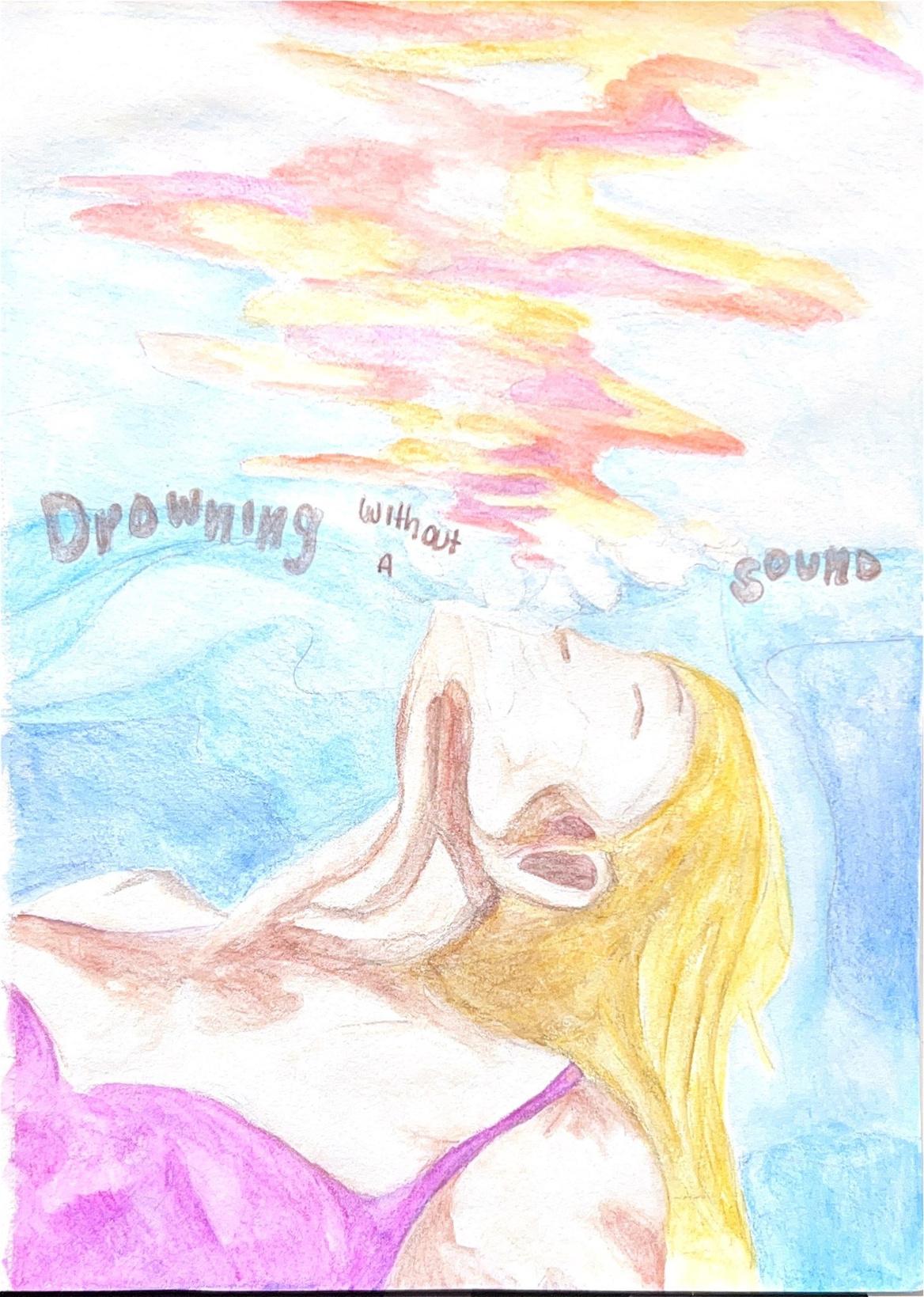

What Even is the Bechdel Test?
By Kaylie NahnThink of the last movie you watched. Now, were there two female characters? Surely there were. But did they have names? Did they talk about something other than a man? Even just once? If you answered no to any of these questions, then the movie you watched just failed the Bechdel test. Bummer.
It may seem absurd that a movie can’t even feature two (only two!) women who have their own identities, dreams, motivations, fears, etc. outside of a man, but it’s more common than you think. Looking at data from the crowdsourced and cross-checked website bechdeltest.com, out of the 9802 movies in its database, nearly 42% of all the movies fail. Why is it that women aren’t fairly represented in film? Does Hollywood think women don’t exist half of the time?
The Bechdel test originated in a 1985 comic strip created by Alison Bechdel, which depicts two friends going to the movies but being
stumped by “the rule” that one friend has when it comes to choosing what to watch: two female characters have to exist and talk about something other than a man. A simple cartoon made to provide some witty and funny commentary on society’s portrayal of women has since gone much further than its intended purpose of being a joke.
The joke has since evolved into a metric in film criticism for measuring female representation. In a recent interview for The Guardian, Alison Bechdel expressed how she never intended for it to be “the real gauge” but it’s cool seeing the impact of the test and how it has sparked discussion over the years.
The test itself elicits the bare minimum for defining what passes as female representation, which sets the bar so low to the point where it’s already hit the floor. Yet, 51% of Oscar Best Picture winners between the years 1929 and 2018 have failed.
Oscar best picture winners that have passed failed the Bechdel Test since 1929
49% pass 51% fail
However, the test may lack nuance due to just how simplified it is. The movie Gravity (2013) features a strong female character who faces grief and explores the human condition, but according to the test, the movie fails due to how there’s only one female character (that being the main protagonist). Meanwhile, many movies that do pass the Bechdel test pass by only a hair and present female characters that are not well developed in the slightest. A film could have dialogue between two women asking each other about the weather for five seconds, and it would still pass.
In Alison Bechdel’s own words, “many movies cynically try to take shortcuts and feature strong female characters – but they just have a veneer of strength and they’re still not fully developed.”
More recently, there have been talks surrounding a new hypothetical test that would account for such nuances by addressing intersectionality.
The Bechdel Test only addresses gender, rather than other aspects of how characters can be represented through race, class, ethnicity, and sexuality.
But whether or not one chooses to consider the Bechdel test as a serious and fair metric, its impact has forever changed the discussion surrounding the advocacy for female representation in film. The test has brought new meaning to how we watch and consume media, and has challenged society's notions of the role of women through not just film, but various art forms and society as a whole as well.
So the next time you watch a movie, ask yourself if women are represented as actual human beings and not accessories.
Ask yourself if this is the example that should be followed for future generations to come. Oh, and also, never let someone mansplain The Godfather (1972) to you.
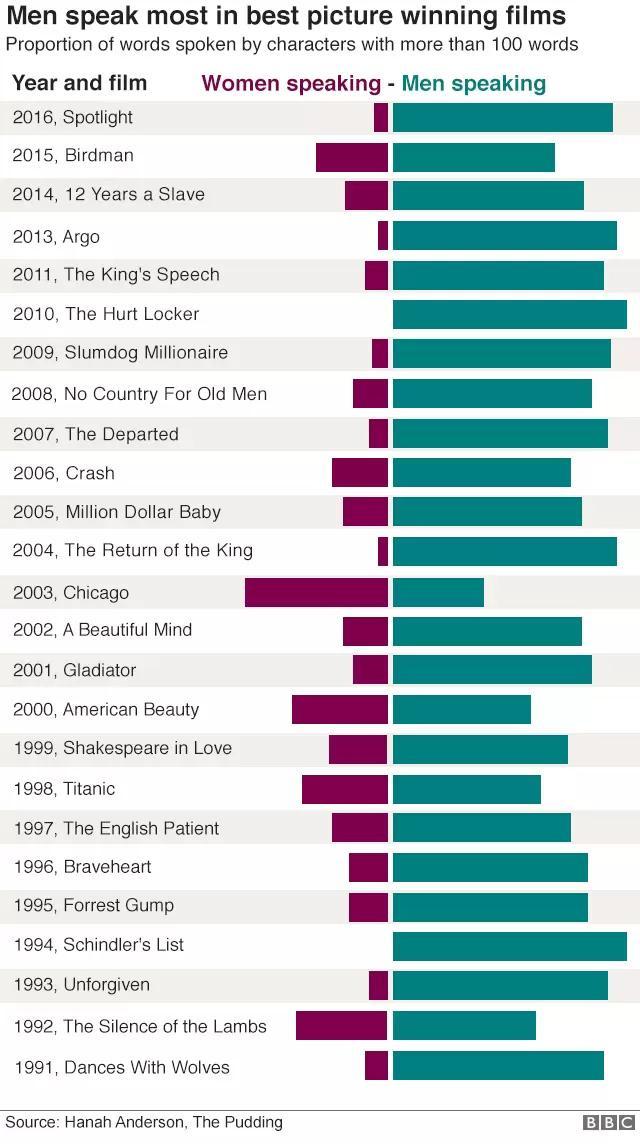 Ms.
Ms.
On Time By
Stout
Recently I have enjoyed two debut novels: Shark Heart: A Love Story by Emily Habeck and The Centre by Ayesha Manazir Siddiqi, both published in 2023, and both available on Libby.
Each novel takes place in a world that is similar to ours but unique in one key aspect. In The Centre, Anisa is drawn to the mysterious titular Centre by the lure of a linguistic shortcut: learn any language completely in just ten days. In Shark Heart, the metamorphosis is physical: humans in this world can undergo rapid genetic mutation into various animals. The clock ticks, counting down Lewis and Wren’s marriage as Lewis’s human heartbeats transform into the rhythm of a shark’s… heart. (He turns into a shark. It puts a strain on their relationship.) Both novels are about changes and how the female protagonists react to and are transformed by the world around them.
Changes in The Centre and Shark Heart: A Love Story occur at different speeds but command the entire attention of the protagonists. The way
characters faced their struggles gripped me as a reader and compelled me to think about my own relationship to time and change. Like Anisa in The Centre I have been tempted to skip steps and take shortcuts to save time, and like Wren in Shark Heart I have feared the inevitable turning of time and what will be waiting for me at the end. Both novels encouraged me to consider the complexity of living in a world that never stops to take a breath.
Anisa, the literary translator at the heart of Siddiqi’s The Centre, is eager to “speedrun” language acquisition. For a fee, she becomes fluent in German, then adds Russian. At first, the Centre is a dream, then a nightmare. At the end, it’s somewhere in between. Anisa must reconcile a fact that we all must learn: there is no magic cure. The Centre delivers on its promise but there are a host of unexpected (but delightfully foreshadowed) consequences Anisa must deal with. Everything in life is in balance and when one aspect shifts, the rest recalibrates.
Anisa achieves success in her career, publishing critically acclaimed translations in her chosen languages. However, the success does not satisfy her and the glow of recognition quickly fades. As a reader, it is clear that her shortcut comes with caveats. As a character, her path to enlightenment is frustrating. In the end it’s unclear if Anisa and I learned the same lesson from her
story. I grieved for Anisa and rooted for her to make better choices.
The plot of the novel Shark Heart is not about finding a cure for Lewis’s rare shark mutation. Instead, the narrative deals with the fallout of such a transformation, both for Lewis himself and for his wife Wren, whom he must leave behind on land. The novel explores Wren’s character and family history, as well as Lewis’s personal and physical metamorphosis into a Great White Shark.
Sharks have to stay in motion, but Wren learns to be still. Wren’s world, like ours, is full of tragedy and loss. Wren discovers that there is power in stillness. She acknowledges there are things she is unable to control, and she finds her peace in enjoying each moment, not worrying about the next. She manages to find Joy in the tragedy of life, and I found joy reading about it.
I have often felt that the world moves too fast around me. Into young adulthood, I felt pressured to speed up to match the pace of my environment. I rushed through assignments, sped through both academic and pleasure reading, and said yes as a default. I often felt guilty about my natural desire for rest, and my tendency towards a slower pace. As I get older, I am becoming more comfortable going at my own glacial speed. I am learning to separate the ideas that “fast” or “first” equals “better” or “best.”
Taking your time can feel transgressive in a society that values speed. Even the verbiage “to take” time implies theft or wastefulness. Taking your time can feel scary, as if everyone is passing you by on the way to some invisible goalpost. Wren found her agency in time-taking, while Anisa appeared to succumb to the temptation of the Centre’s shortcut. Both novels encouraged me to reflect on my own relationship with time and tempo. Last spring I turned thirty, and entering a new decade has come with an invisible set of expectations and time limits. Women in particular are expected to be consummate time managers, to be selfless emotional support for those around them, and to achieve traditional markers of age like marriage, motherhood, and having a go-to CrockPot recipe. It feels like society believes a woman should have figured it all out by thirty, and if she hasn’t, the clock is ticking. I am lucky to have supportive and thoughtful friends at many different life stages. Talking to my friends, like reading novels, allows me to access multiple perspectives and in doing so, get to know myself even better. I am growing comfortable moving at my own pace and being unapologetically selfish with my time.
DariaKasatkina
By Marshall O’Callaghan
Often as a society, or in feminism, we tend to associate individual excellence with the end goals of an overall movement. Picking a paragon of excellence in one field or another, we are quick to laud scientists, authors, and business executives for excellence in their personal representation and achievement of an ideal without diving deeper into their commitment to what exactly that ideal serves.
In New York, on September 4, 2023, Russian tennis player Daria Kasatkina fell to Belarussian and now-world-number-one Aryna Sabalenka in the fourth round of the US Open. On an individual level, each athlete serves as a paragon of the feminist ideal; each is a professional athlete at the top of her sport, competing in an event that promises equal prize money to both men and women, and in doing so in an internationally significant tournament, they are showing thousands of young girls from Toronto to Tehran that they can belong on any stage that they want.

Through the lens of current events that seems to shade all perspectives, this match couldn’t really have a favorable outcome when factoring in geopolitical issues, at least at first glance. This result will either represent a victory for Russia or Belarus, the two nations most directly involved in the invasion of Ukraine (although both players are playing under no national flag), and as is often the case, it seems likely that the athletic successes of formerly Soviet powers will be used as propaganda Sometimes, however, Occam's Razor proves insufficient, and you need to dig deeper for the true solution.
Defying what seems to be an endless set of systems designed to breed standardization and conformity, Daria Kasatkina has never been one to shy away from being a changemaker. Born five years after the fall of the Soviet Union to a pair of nationally recognized athletes, it seemed that Kasatkina’s career in sports had already been predestined by the Russian sports machine. At the age of six, she first began playing competitive tennis. Kastikina broke out at a young age, performing well as a junior and establishing herself as one of the brightest new players on tour in the late 2010s. She seemed destined to follow in the long line of Russian Women’s tennis success, and a strong performance in 2021 cemented her in this role. For most players, overcoming the initial hurdle of success and turning the corner to consistency throughout seasons represents a major turning point in a career and a cause for celebration; Kasatkina had finally reached that point in 2021.
Just as she began carving out a lasting niche and legacy, finding a final sense of stability in life,

her world and the world around her were shaken by the Russian invasion of Ukraine.
At the onset of this invasion, most Russian athletes didn’t comment on the war. Many feared violence against their families or bans from returning to the country that they considered home; for Kasatkina it seemed as though there was no other option except to voice her strong opposition to the war; in an interview with Vitya Kravchencko, she described the war as a “nightmare” and expressed sympathy towards the people of Ukraine, a more vocal criticism of the war than any other Russian athlete has offered. Like many others, Kasatkina has family back home in her country, yet unlike her fellow countrymen and women, Kasatkina is something of an outlaw herself
In the same interview, mere moments after her criticism of the war, Kasatkina committed her second “criminal action ” Her acknowledgement and criticism of the Russo-Ukrainian conflict as a violent invasion was the first, and her coming out of the closet and announcing her relationship with her girlfriend was the second For her actions, there is a high likelihood that Kasatkina will not be allowed back into Russia under the current regime; her home in Russia, unoccupied at the time, has been raided, and she is a political enemy of the Russian state. The bravery to make herself a target through even a single interview is commendable, but Kasatkina didn’t commit these acts to be a role model; she did because they were right.
Kasatkina and her girlfriend share a YouTube channel on which they post vlogs about what it is like living on tour. In other interviews about war and sexuality, Kasatkina is serious and distraught; she seems to have a kind of solemn sorrow that feels genuine but emotionally disheartening to any viewer. Here, however, the real Kasatkina shines through. Though she is a capable and powerful speaker, able to address some of the most challenging issues of the day with an intelligent and informed opinion, she seems much more comfortable engaging in the smaller kindnesses; she stays to sign memorabilia for fans after practices and matches, and she treats each member of the tournament staff with the utmost care and respect. Kasatkina is a paragon of not only her causes, but of humanity itself, as she seems simply drawn toward morality and kindness Kasatkina could have said nothing, as many athletes did, ensuring she and her family remained safe, or she could have been vague and general in her criticisms and stances on the war and on gay rights; most people would do little more than bat an eye and focus on examining her career on the court. Instead, she has chosen to lead both on and off the court, through action and example.

WYOMING:THEFIRSTFRONTIEROF WOMEN’SSUFFRAGE
BY VICTORIA TODMAN
“It is a very cheap wit that finds it so droll that a woman should vote. If the wants, the passions, the vices, are allowed a full vote, through the hands of a half-brutal, intemperate population, I think it but fair that the virtues, the aspirations, should be allowed a full voice as an offset, through the purest of the people.”
-Ralph Waldo EmersonThe topic of women's suffrage has been contentious throughout American history, the battle culminating in the adoption of the 19th Amendment 144 years after the country's founding. Many U.S. leaders rejected the idea of women voting, fearing it would unsex them or turn them against their husbands. Still, in 1869, Wyoming became the first territory, and in 1890, the first state, to grant women suffrage. Despite initial challenges, Wyoming now known as “The Equality State” expanded the frontier of women's suffrage in America by establishing a precedent of equal suffrage, spearheaded by influential figures like William Bright and Esther Hobart Morris, and its successful test paved the way for nationwide suffrage. Wyoming, through influential figures such as William Bright and Esther Morris, became the first commonwealth to adopt women’s suffrage. It was considered to be a trial of women’s suffrage throughout the nation, and, after it was thoroughly established, was widely considered a success. The implementation of women's suffrage led to a host of reforms benefiting underprivileged citizens. This showcased the advantages of equal suffrage and catalyzed the extension of women's voting rights across numerous other Western states. Thus, “The Equality State” extended the frontier of women’s suffrage throughout America, paving the way for the 19th Amendment.
created by Aashni Shah
Across
The termination of a pregnancy
A U.S. law that prohibits sex-based discrimination in federally funded education programs Being mindful of all dimensions of human differences

A hatred, dislike, or prejudice against women
Present day unjust social system that subordinates, discriminates, or is oppressive to women
An invisible barrier that refers to the limits women can reach in their careers due to gender discrimination
The way in which different factors of discrimination cant meet at an intersection and can affect someone's life.
A principle in feminism promotes the idea that all individuals, regardless of gender, should be included
A woman who fought for womens' right to vote
A movement that encourages individuals to embrace and love their bodies as they are
answers on page 29

What Flower

Are You?
By Tanmayee IskapalliPick a Color
A. Pink B. White
C. Blue D. Red
Pick an Ice Cream Flavor
A. Strawberry B. Vanilla
C. Cookie Dough D. Chocolate
A. Cake B. Macarons
C. Cookies D. Donuts
A. Caring B. Reliable
C. Outgoing D. Honest
Down:
2. intersectionality
4. inclusivity
5. suffragette
6. bodypositivity
